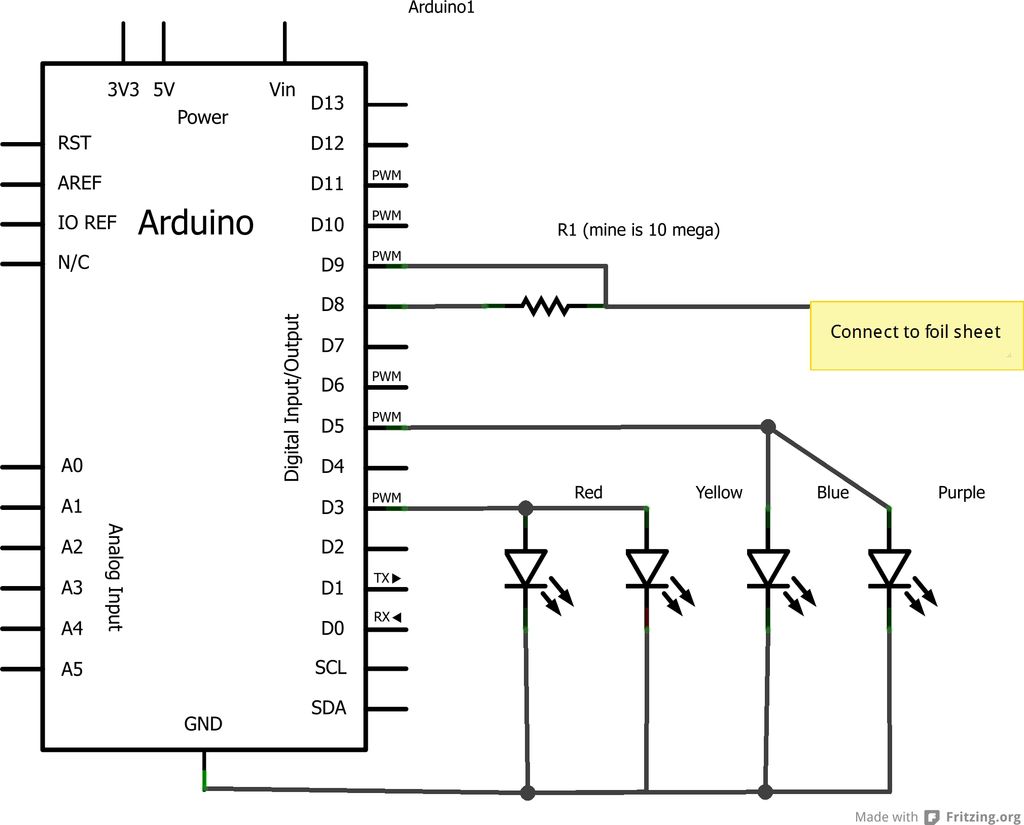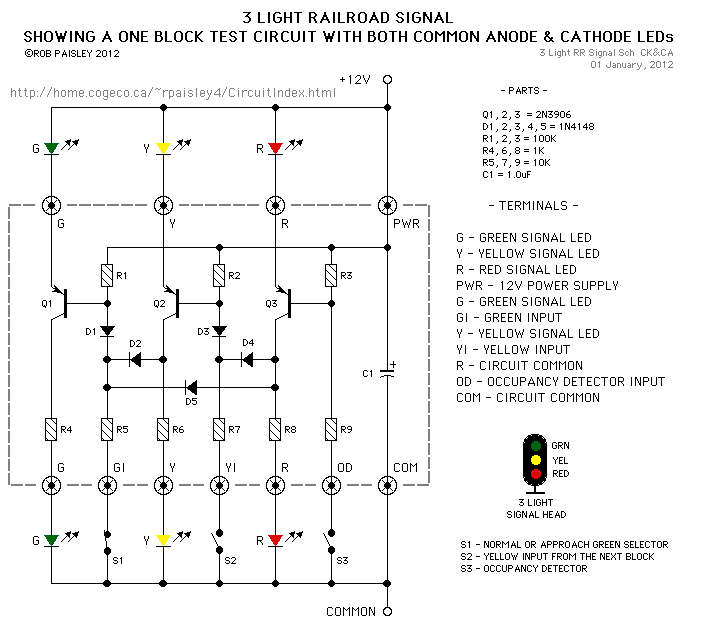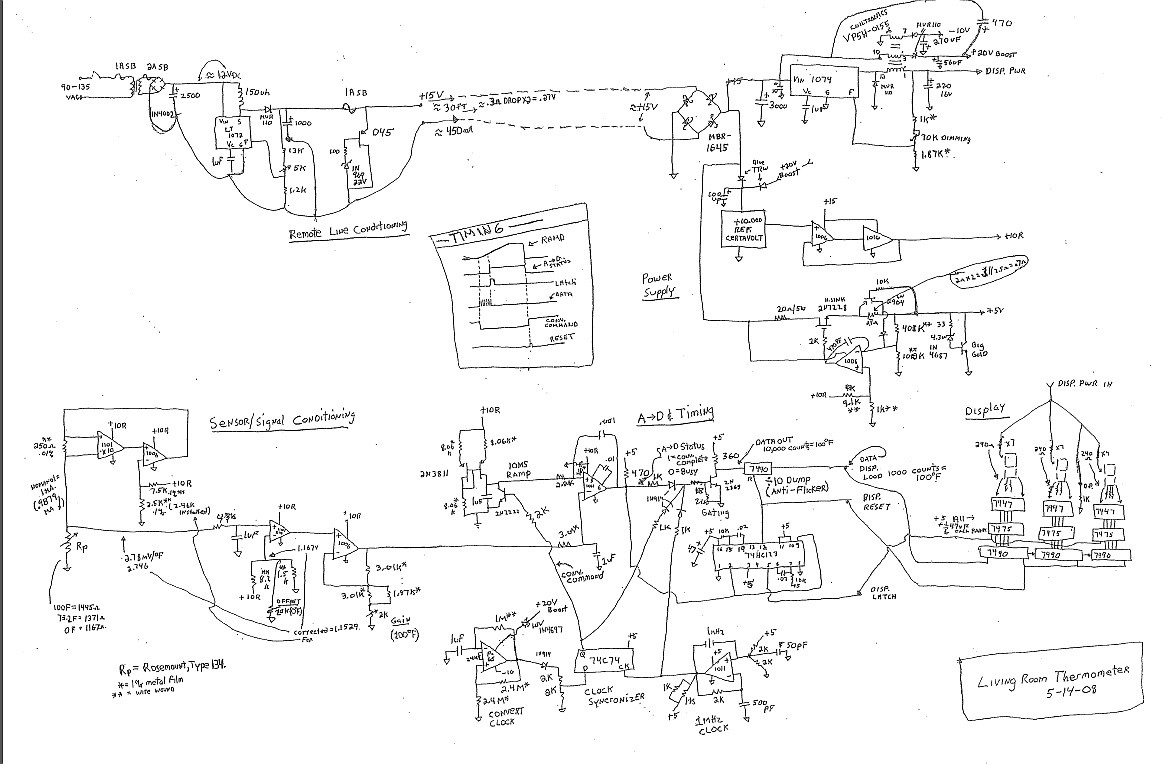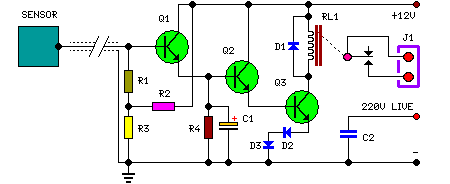
Magic Light Capacitance Sensor using an Arduino

This project is an Arduino-based light control system that is ideal for beginners. It allows the fading of colors or lights by detecting hand movements nearby. The system transitions from a purple-blue hue to a fiery red-orange. The assembly is straightforward, and the coding process is manageable, making it an impressive demonstration for onlookers. It was gifted to a family member during the holiday season and received positive feedback. To operate the system, it is necessary to run the code and access the serial monitor. It is recommended to position the setup away from the computer to minimize interference. Users should take note of the output values when no object is near the foil sensor, as well as the values when an open palm is very close to the sensor. Frequent adjustments may be required to calibrate the light due to various factors that can affect the readings, necessitating recalibration whenever the setup is relocated.
This Arduino project utilizes a simple circuit to control an RGB LED or a series of LEDs that can change colors based on proximity sensing. The main components typically include an Arduino board (such as the Arduino Uno), an RGB LED, a foil sensor or capacitive touch sensor, and a resistor.
The RGB LED is connected to the Arduino's PWM-capable pins, allowing for smooth color transitions. The foil sensor is used to detect the presence of a hand and is connected to one of the analog input pins on the Arduino. A resistor may be placed in series with the LED to limit current and prevent damage to the LED.
The code for this project involves reading the analog values from the foil sensor, which fluctuate based on the proximity of an object. When an object, like a hand, approaches the sensor, the readings will change significantly. The code should include calibration routines to establish baseline readings when no object is present and adjust for maximum readings when a hand is close. These readings will determine the color transitions of the LED.
In operation, the user will observe the LED gradually changing colors in response to hand movements. The project serves as an excellent introduction to basic electronics, programming, and the principles of capacitive sensing. It also provides a visually engaging way to demonstrate the capabilities of Arduino in creating interactive projects. Regular recalibration may be necessary to maintain accurate sensor readings, especially if the setup is moved to a different environment. This project exemplifies the potential of Arduino for creating fun and interactive electronic devices.This was my very first arduino project. Its great for beginners. Fade the color or the lights my moving your hands near it. It fades from a pretty purple blue to a firey red-orange. Its was SUPER easy to build, not to hard to write the code, and its really impresses people! I gave it to my mother for christmas, and it was a big hit. Watch the vide o to see it in action! I apologizefor the poor quality, I will try to take more pictures. Once it is set up, run the code and open the serial monitor. Move the set up away from your computer to help diminishinterference Note what numbers are being out put when nothing is near the foil sensor, also note what it is when your open palm isextremelyclose to the sensor. You will have to adjust these numbers often to calibrate the light. Many factor interfere with the readings to it needs to be set up whenever it is moved. 🔗 External reference
This Arduino project utilizes a simple circuit to control an RGB LED or a series of LEDs that can change colors based on proximity sensing. The main components typically include an Arduino board (such as the Arduino Uno), an RGB LED, a foil sensor or capacitive touch sensor, and a resistor.
The RGB LED is connected to the Arduino's PWM-capable pins, allowing for smooth color transitions. The foil sensor is used to detect the presence of a hand and is connected to one of the analog input pins on the Arduino. A resistor may be placed in series with the LED to limit current and prevent damage to the LED.
The code for this project involves reading the analog values from the foil sensor, which fluctuate based on the proximity of an object. When an object, like a hand, approaches the sensor, the readings will change significantly. The code should include calibration routines to establish baseline readings when no object is present and adjust for maximum readings when a hand is close. These readings will determine the color transitions of the LED.
In operation, the user will observe the LED gradually changing colors in response to hand movements. The project serves as an excellent introduction to basic electronics, programming, and the principles of capacitive sensing. It also provides a visually engaging way to demonstrate the capabilities of Arduino in creating interactive projects. Regular recalibration may be necessary to maintain accurate sensor readings, especially if the setup is moved to a different environment. This project exemplifies the potential of Arduino for creating fun and interactive electronic devices.This was my very first arduino project. Its great for beginners. Fade the color or the lights my moving your hands near it. It fades from a pretty purple blue to a firey red-orange. Its was SUPER easy to build, not to hard to write the code, and its really impresses people! I gave it to my mother for christmas, and it was a big hit. Watch the vide o to see it in action! I apologizefor the poor quality, I will try to take more pictures. Once it is set up, run the code and open the serial monitor. Move the set up away from your computer to help diminishinterference Note what numbers are being out put when nothing is near the foil sensor, also note what it is when your open palm isextremelyclose to the sensor. You will have to adjust these numbers often to calibrate the light. Many factor interfere with the readings to it needs to be set up whenever it is moved. 🔗 External reference





